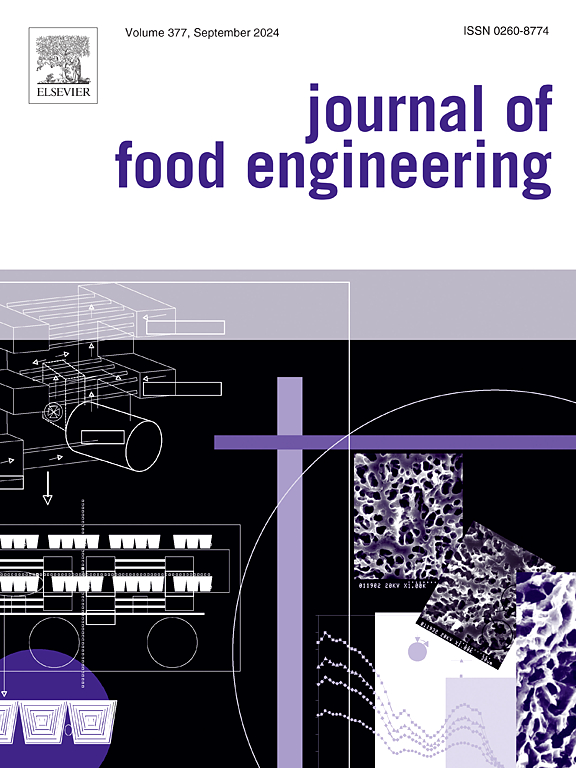Effects of rice starch-soy protein isolate interactions on the structural characteristics and digestive behaviors
IF 5.3
2区 农林科学
Q1 ENGINEERING, CHEMICAL
引用次数: 0
Abstract
Starch-protein complexes are regarded as an effective strategy in regulating the digestion behavior of starch. Nevertheless, the anti-digestive mechanisms of soy protein isolate (SPI) on the digestibility of rice starch (RS) remain unclear. This study aimed to investigate how the structural characteristics of RS-SPI complexes influence the adsorption of amylase on the gel surface and the internal mobility of amylase by comprehensively comparing the structural, morphologic, rheological and digestive properties of RS with RS-SPI complexes. Results showed that SPI interacted with RS by non-covalent (ionic bonds, hydrogen bonds, and hydrophobic interactions), and the gelatinization properties of RS were changed significantly by the addition of SPI. Besides, compared to RS, RS-SPI complexes had stranger V-type diffraction intensity, more compact gel network structure, larger particle sizes and weaker affinity with α-amylase, which were closely related to the anti-digestive properties of the complexes. Furthermore, RS-SPI complexes showed lower apparent viscosity and dynamic viscoelasticity than those of RS. With the increase of SPI content, in vitro digestion study confirmed that the content of resistant starch was increased from 3.57 % (RS) to 25.24 % (RS-40 %SPI) and the digestibility was decreased from 98.90 % (RS) to 77.91 % (RS-40 %SPI). Collectively, the present study unveiled the mechanisms of SPI on the digestibility of RS by hindering the binding of amylase to RS, which provided a valuable suggestion on the development of healthy foods with anti-digestive properties.
大米淀粉-大豆分离蛋白互作对结构特性和消化行为的影响
淀粉蛋白复合物被认为是调节淀粉消化行为的有效策略。然而,大豆分离蛋白(SPI)对大米淀粉(RS)消化率的抗消化机制尚不清楚。本研究旨在通过对RS与RS- spi配合物的结构、形态、流变学和消化性能的综合比较,探讨RS- spi配合物的结构特征对淀粉酶在凝胶表面吸附和淀粉酶内部迁移率的影响。结果表明,SPI与RS之间存在非共价键(离子键、氢键和疏水键)相互作用,SPI的加入显著改变了RS的糊化性能。此外,与RS相比,RS- spi配合物的v型衍射强度更强,凝胶网络结构更致密,粒径更大,与α-淀粉酶的亲和力更弱,这与配合物的抗消化性能密切相关。体外消化试验表明,随着SPI含量的增加,抗性淀粉含量从3.57% (RS)增加到25.24% (RS- 40% SPI),消化率从98.90% (RS)降低到77.91% (RS- 40% SPI)。综上所述,本研究揭示了SPI通过阻碍淀粉酶与RS的结合而影响RS消化率的机制,为抗消化健康食品的开发提供了有价值的建议。
本文章由计算机程序翻译,如有差异,请以英文原文为准。
求助全文
约1分钟内获得全文
求助全文
来源期刊

Journal of Food Engineering
工程技术-工程:化工
CiteScore
11.80
自引率
5.50%
发文量
275
审稿时长
24 days
期刊介绍:
The journal publishes original research and review papers on any subject at the interface between food and engineering, particularly those of relevance to industry, including:
Engineering properties of foods, food physics and physical chemistry; processing, measurement, control, packaging, storage and distribution; engineering aspects of the design and production of novel foods and of food service and catering; design and operation of food processes, plant and equipment; economics of food engineering, including the economics of alternative processes.
Accounts of food engineering achievements are of particular value.
 求助内容:
求助内容: 应助结果提醒方式:
应助结果提醒方式:


